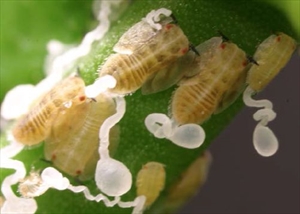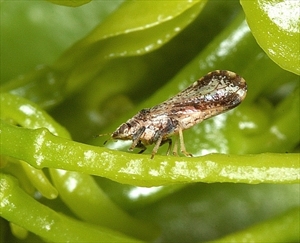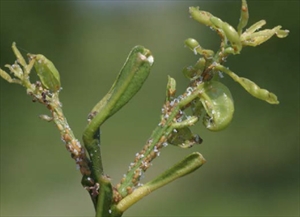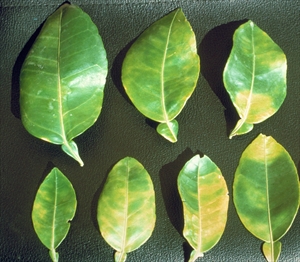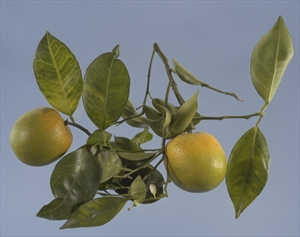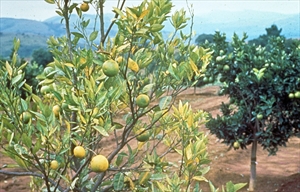Asian (or Asiatic) citrus psyllid
Pacific Pests, Pathogens and Weeds - Online edition
Pacific Pests, Pathogens & Weeds
Citrus psyllid (185)
Diaphorina citri
Asia, North, South and Central America, the Caribbean, restricted in Africa (Mauritius and Reunion), Oceania. It is recorded from American Samoa, Guam, Northern Mariana Islands, Papua New Guinea, and Samoa. It no longer occurs in Australia, where it was eradicated.
The Asian psyllid occurs on members of the citrus family, the Rutaceae. It occurs on ornamentals and wild hosts as well as on citrus. It especially favours grapefruit, kumquat, lemons, limes, mandarin, orange, pomelo and tangelo. Murraya paniculata, a plant often used for hedges, is also a host, as is the curry tree (Bergera koenigii).
Eggs are yellow-orange, somewhat oval (almond shape), laid near the tip of the shoots, in folds of the young leaves, on leaf stalks (petioles), stems, and buds (Photo 1). After about 4 days the eggs hatch producing orange nymphs which at first crowd together, feeding on the tender shoots. They produce honeydew and also a white thread-like waxy substance (Photo 2). These fall on the leaves below and sooty mould fungi grow on them turning the leaves black. The nymph stage lasts about 12 days and during that time the nymphs moult several times.
The adults have wings with brown patches, but their characteristic feature is the feeding position (Photo 3). The head reaches downwards, almost to the plant surface with the body held at about 40 degrees. They usually feed on the underside of the leaf, jumping or flying short distances when disturbed.
The psyllid reproduces best at temperatures between 25 and 28°C. Under these conditions, the female lays between 400 and 800 eggs and remains alive for about 50 days. From egg to adult is about 15 days, and this means populations increase rapidly. Eggs and nymphs can only be found when leaf flushes occur, but adults occur throughout the year.
Adults are poor fliers rarely flying for more than 100 m at one time. Spread of the psyllid occurs by wind and via the trade in plants moving within and between countries.
The psyllid damages plants in two ways. It sucks the sap from young shoots causing stunting, distortions and sometimes death (Photo 4). Badly twisted leaves fall prematurely. Leaves also become covered with honeydew and sooty mould. Young flowers fall and fruits drop. Twigs dieback when infestations are heavy.
The Asian citrus psyllid transmits greening disease, also known as 'huanglongbing' (yellow dragon disease). It is caused by a type of bacterium called Candidatus Liberibacter asiaticus which occurs inside the plant, in the phloem of the vascular tissues. There are three strains of the bacterium.
Symptoms of the disease are difficult to tell from lack of nutrients; they look similar to zinc deficiency. However, leaves on one branch or part of a branch turn pale yellow, or show blotches of yellow and green; sometimes the green areas are only along the veins (known as 'vein-banding') (Photos 5&6). Within a year, all the leaves of the tree turn yellow, some fall, and there is no fruit production, or the fruits are small, misshapen with uneven colour - the stalk end is orange and the bottom is green - and the taste is bitter. The colour of the bottom of the fruit gives the diseases is common name: 'greening'. Eventually, the trees dieback (Photo 7).
The psyllid feeds on infected plants and takes up the bacterium in under an hour. Eight to 12 days later it can infect other plants, after feeding on them for about 24 hours. Importantly, symptoms take at least a year to develop before they become noticeable; by then the disease has been distributed widely.
Look for the eggs, nymphs with their waxy threads, and adult phyllids on new flushes of citrus, every 14 days during the time when flower buds open. Look for the adults especially on the underside of mature leaves - they hold their bodies at 40 degrees from the plant surface. Look for sooty moulds on the leaves.
QUARANTINE
Countries not yet infested by the citrus psyllid should take special precautions against its introduction. They should follow the FAO/IBPGR Technical Guidelines for the Safe Movement of Citrus Germplasm (http://www.bioversityinternational.org/e-library/publications/detail/faolbpgr-technical-guidelines-for-the-safe-movement-of-citrus-germplasm/).
Note, it is unlikely that the psyllid would be eradicated should it be introduced; furthermore, once a tree has developed huanglongbing disease there is no cure. Invariably, 2 years or so after the introduction of the psyllid to a new location, huanglongbing disease occurs.
CULTURAL CONTROL
Before planting:
- Check that the plants are free from psyllids before growing them in a nursery or in the field. Plants should only be bought from commercial nurseries where the health status of the plants is known. If they come from nurseries where there are citrus orchards, make sure that the plants are free from psyllids before planting them in your field. If psyllids are present, immediately report the occurrence to agricultural authorities (or biosecurity organisation).
- Make sure that everyone on your farm knows the importance of the citrus psyllid, its life cycle, and the symptoms that it causes, as well as those of huanglongbing. It is important they know what to do if they suspect the psyllid is present or trees show signs of the disease.
During growth:
- Monitor plants in the field for psyllids at least once a month. Keep records of these monitoring visits
- If you think that the psyllid is present, or plants have signs of huanglongbing, do not take a sample, take photos and immediately inform your government agricultural authorities and seek advice.
CHEMICAL CONTROL
Consult your agricultural authorities before using pesticides for the control of the psyllid. Use pesticides during periods of flushing:
- Use botanical (plant-derived pesticides) sprays, as these may cause less harm to natural enemies, and cost less than synthetic commercial products.
- Use neem or pyrethrum. If these are used, add soap to help the chemical reach into the flowers and the tightly furled leaves.
- Use pyrethroids or neonicotinoids, e.g., imidachloprid, if synthetic products are required.
____________________
When using a pesticide, always wear protective clothing and follow the instructions on the product label, such as dosage, timing of application, and pre-harvest interval. Recommendations will vary with the crop and system of cultivation. Expert advice on the most appropriate pesticides to use should always be sought from local agricultural authorities.
AUTHOR Grahame Jackson
Information from CABI (2020) Diaphorina citri (Asian citri psyllid). Crop Protection Compendium. (https://www.cabi.org/cpc/datasheet/18615); and Asian citrus psyllid Diaphorina citri (2019). Department of Agriculture Water and the Environment. (https://www.agriculture.gov.au/biosecurity/australia/naqs/naqs-target-lists/pests_of_plants_asian_citrus_psyllid); Plant Biosecurity and Product Integrity (2017) Asian citrus psyllid. Department of Primary Industries, NSW, Australia; and from Asian citrus psyllid (undated) Department of Employment, Economic Development and Innovation. Biosecurity Queensland. (https://www.daf.qld.gov.au/__data/assets/pdf_file/0012/73110/Citrus-Asian-citrus-psyllid.pdf); and from Asian citrus psyllid (2019) Business Queensland. Queensland Government (https://www.business.qld.gov.au/industries/farms-fishing-forestry/agriculture/crop-growing/priority-pest-disease/asian-citrus-psyllid). Photos 1&3 David Hall, USDA Agricultural Research Service, Bugwood.org. Photo 2 Michael Rogers, University of Florida. Photo 4 Michael Rogers, University of Florida. Photo 5 JM Bove, INRA Centre de Recherches de Bordeaux, Bugwood.org. Photo 6 Jeffery W. Lotz, Florida Department of Agriculture and Consumer Services, Bugwood.org. Photo 7 HD Catling, Bugwood.org.
Produced with support from the Australian Centre for International Agricultural Research under project PC/2010/090: Strengthening integrated crop management research in the Pacific Islands in support of sustainable intensification of high-value crop production, implemented by the University of Queensland and the Secretariat of the Pacific Community.

